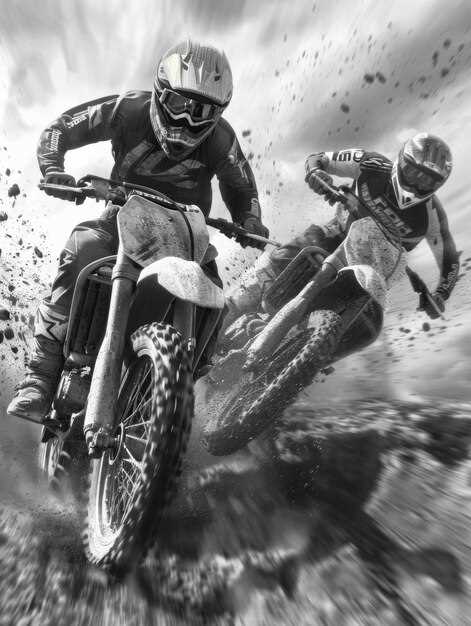
When it comes to the world of motorcycle sports, two prominent disciplines stand out: road racing and motocross. Both forms offer exhilarating experiences and passionate fanbases, yet they differ significantly in terms of terrain, racing style, and technical skills required. Understanding these key differences can enhance appreciation for each sport and help enthusiasts determine which aligns best with their interests.
Road racing primarily takes place on paved surfaces, emphasizing speed and precision on closed circuits or public roads. Competitors often push their machines to the limit, showcasing their skills in handling, cornering, and tactical overtaking maneuvers. The focus is on mastering the art of speed, where aerodynamics and lightweight design play critical roles.
In contrast, motocross thrives in off-road environments, featuring rough terrains filled with jumps, dirt hills, and various obstacles. This discipline requires not only speed but also exceptional control and adaptability as riders navigate unpredictable landscapes. The ability to execute jumps and land smoothly is crucial, making physical endurance and technical agility vital components of motocross racing.
Understanding the Terrain: Road Tracks vs. Motocross Courses
The primary distinction between road tracks and motocross courses lies in their design and the type of terrain they encompass. Road tracks are typically smooth, paved surfaces that favor high-speed racing, enabling riders to maintain consistent traction and momentum. The layout often includes sweeping turns, long straights, and elevation changes, which challenge the rider’s precision and control at high speeds.
In contrast, motocross courses are intentionally rugged and varied. These tracks feature various obstacles such as jumps, hills, and an assortment of natural and man-made elements that demand a different skill set. Riders must navigate through soft dirt, mud, and sometimes even sand, which requires adept handling and an understanding of traction dynamics to avoid losing control.
Moreover, the length and complexity of these tracks vary significantly. Road tracks can be several kilometers long with intricate configurations designed for speed, while motocross courses might be shorter but contain numerous technical elements that require agility and quick reflexes. The ability to adapt to changing conditions is crucial in motocross, where weather can directly affect track performance.
Ultimately, understanding the terrain of both road and motocross tracks enhances the racing experience. Each type of track presents its unique challenges, emphasizing different aspects of riding talent and strategy. Knowledge of these differences not only informs rider preparation but also deepens appreciation for each discipline.
Choosing the Right Vehicle: Features of Road Racing Bikes vs. Motocross Bikes

When it comes to choosing the right vehicle for racing, understanding the distinct characteristics of road racing bikes and motocross bikes is essential. Each type is specifically designed for its respective environment, leading to significant differences in features.
Road racing bikes are engineered for high-speed performance on paved tracks. They typically feature a lightweight frame, aerodynamic design, and high-performance tires that provide optimal grip on smooth surfaces. The engines are finely tuned for maximum power and efficiency, enabling riders to achieve high speeds while maintaining control. Suspension systems on road bikes are calibrated to handle less rugged terrain, focusing instead on stability during high-speed turns.
In contrast, motocross bikes are built for rugged, off-road conditions. These vehicles have a more robust frame and longer suspension travel to absorb shocks from jumps and uneven terrain. The tires are knobby and designed for traction on dirt and mud, allowing riders to navigate through obstacles effectively. Motocross bikes often have engines that deliver quick acceleration, which is crucial for starting off the line and maintaining speed on unpredictable surfaces.
Both types of bikes offer different riding experiences and require specific skill sets. While road racing emphasizes precision and speed on a closed track, motocross demands agility and adaptability to varying outdoor conditions. Ultimately, the choice between a road racing bike and a motocross bike should be guided by the rider’s preferred environment and racing style.
Exploring Race Strategies: Tactics for Success in Road Racing and Motocross

Success in both road racing and motocross relies heavily on well-defined race strategies tailored to their unique environments. In road racing, where the track is typically smooth and uniform, tactics often focus on maintaining optimal speed and achieving seamless cornering. Pilots analyze the track layout to identify critical points for overtaking, braking zones, and acceleration phases. Precise throttle control and aerodynamic positioning play significant roles in maximizing speed and stability throughout the race.
Conversely, motocross demands a different set of strategies. The off-road terrain presents obstacles such as jumps, berms, and varied surfaces, requiring riders to adapt quickly. Riders must focus on bike handling and body positioning to maintain balance over uneven terrain. Techniques such as seat bouncing, scrubbing jumps, and using the throttle to absorb off-road bumps are essential. Additionally, understanding the bike’s suspension and tire grip provides a competitive edge on a varying track surface.
Moreover, mental preparation impacts strategy in both racing formats. Road racers often visualize their laps to refine their approach to specific corners while maintaining a focus on pace management throughout the race. In motocross, visualizing key jumps and transitions allows riders to mentally prepare for the challenges ahead, especially in proactively reacting to competitors’ moves on the chaotic track.
In summary, while road racing emphasizes speed, precision, and tactical overtaking on a smooth track, motocross requires agility, adaptability, and technical skill to navigate diverse obstacles effectively. Both disciplines benefit from thorough preparation and a deep understanding of the unique demands of their respective racing environments.












